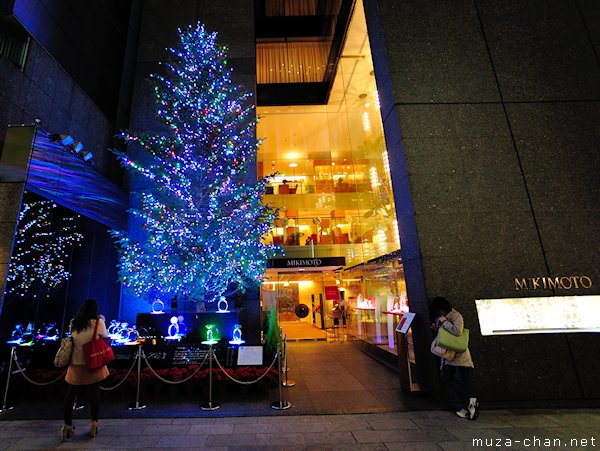Since the number of Christians in Japan is relatively low (under 1%), the Christmas day is not a national holiday and the Christmas in Japan is mainly a commercial event. However, there are several typical Christmas customs and traditions taking place in Japan in a manner very similar to the Christmas celebrations of the Christian countries. Let’s have a look:
1. Christmas tree in Japan
The tradition of the Christmas tree was brought into Japan by Christian missionaries, but the first modern Christmas tree appeared in Ginza, around 1910.
At the beginning, the Japanese decorated the Christmas tree with Japanese specific ornaments: small fans and paper lanterns, origami birds, animals… or even Santa Claus:
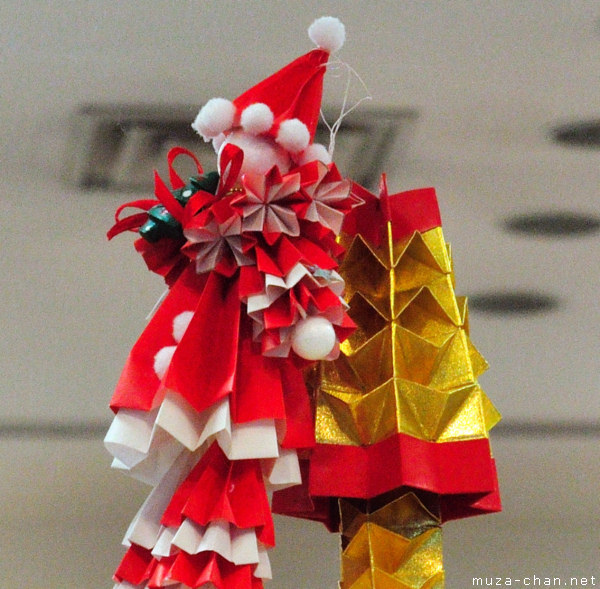
Santa Claus Origami
After a while, Japan started producing Christmas decorations in western style and during the 1920s Japan became the main manufacturer of Christmas decorations, Christmas tree lights, artificial Christmas trees (which were made from aluminum) and Christmas toys.
The Christmas related merchandise was sold in Europe and United States.
Two years ago, one of the most unusual Christmas trees was made in Japan from 50000 sardines, at Hakkeijima Sea Paradise in Yokohama.
Last year, Japan was on the Christmas news again with the Enoshima Aquarium, where the lights from the tree were powered by… an electric eel:
And this year, the most expensive Christmas tree in the world is displayed at the famous Tanaka Ginza jewelry shop. It is 2.4 meters tall and, being made of 12 kilograms of pure gold, its value is over 2 million dollars!
2. Samurai, Doraemon and Robots, Short History of Santa in Japan
The earliest record of a Christmas celebration in Japan was in 1552, when a Jesuit missionary held a mass in the Yamaguchi prefecture. However, it is believed that small Christmas celebrations took place earlier, starting in 1549, when Saint Francis Xavier arrived in Japan. The tradition continued until 1635, when the Tokugawa Shogunate prohibited the Christian religion with the Sakoku Edict.
For approx. 230 years, the Christian religion was practiced secretly by kakure kirishitan (hidden Christians). But with the Meiji restoration, the Christian religion became legal again and, under the Western influence, the celebration of Christmas was resumed. At the same time with the Christmas celebrations, Santa Claus also appeared in Japan (サンタさん Santa-san, or サンタクロース Santa Kurōsu).
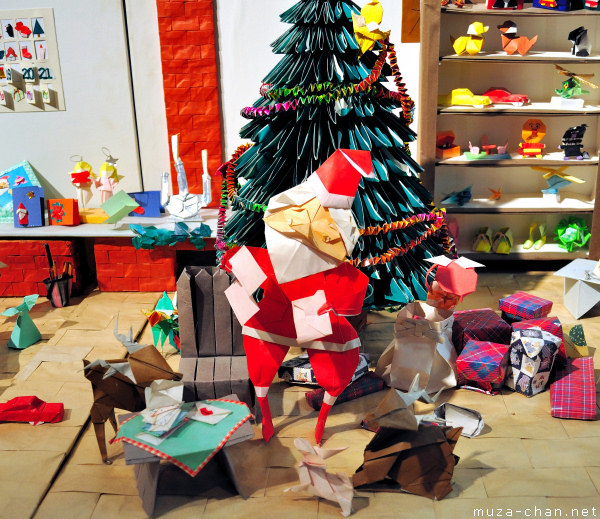
Santa Claus Origami
In 1875 in Tokyo, at the Harajo School from Ginza, a Santa Claus dressed as a… Samurai appeared at the Christmas celebration and several years later, in 1898, a book for children about Santa was published, called Santakuro.
So it’s no wonder that in the anime culture a Doraemon Santa also appeared… Here’s a plush toy seen this summer in a shop on Nakamise Dori, Asakusa, probably left there since the last Christmas:
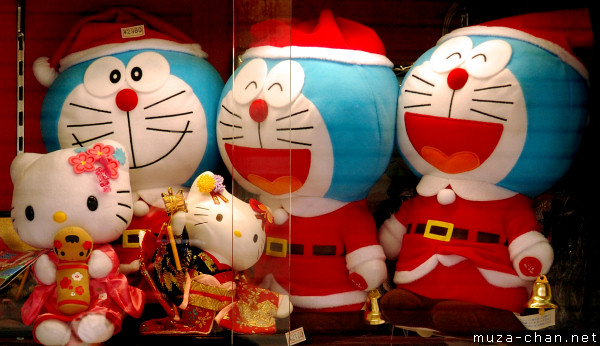
And from a figure representing a robot to a real robot is just a step… Last year, a group of robots, 夢ROBO (Yume ROBO, meaning Dream ROBO) were continuously climbing up and down the walls of Tenmabashi Station from Osaka:
3. From Hotei to Santa Claus
Santa Claus was quickly adopted in Japan, even if its legend is not related to the main religions practiced in Japan. However, there is an interesting similarity that, according to some researchers, might have helped.
Hotei, the God of Contentment and Happiness, is a folkloric deity from China, where it is known as Budai (or Putai).
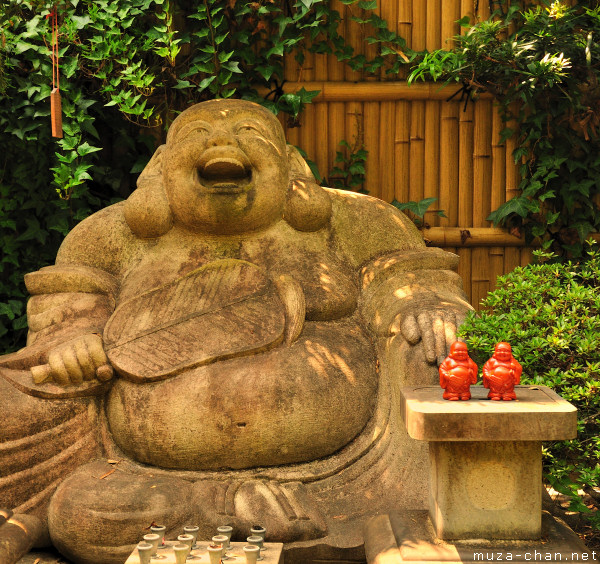
Hotei statue in Ueno, Tokyo
According to the Chinese tradition, Budai was a Zen Buddhist monk named Qieci (Budaishi in Japanese), who lived in the 10th century and is considered to have been an incarnation of Bodhisattva Miroku (Miroku Bosatsu in Japanese, Maitreya in Sanskrit).
In Japan, Hotei is one of the Seven Gods of Luck (Shichifukujin), God of satisfaction, abundance and happiness, patron of children, fortunetellers and… bartenders.
Hotei is represented as a Buddhist monk with a shaved head, cheerful face and a big belly, symbolizing the largeness of his soul.
In his hands he often holds an oogi (Chinese fan) used during the old times by the nobles to indicate to their subjects that their requests would be granted.
During the modern times, Hotei/Budai also became popular in America (with the nickname Laughing Buddha or Fat Buddha) and his statues can often be seen in the Chinese restaurants.
The similarities between Hotei and Santa Claus may come from Hotei’s representations with a large linen bag on his back (which also gives his Japanese name, Ho Tei meaning “cloth bag"). In the bag he carries gifts and fortunes for those who believe in his virtues or for the poor and needy and it is said that his bag never empties.
He is also often depicted surrounded by small children playing around him, and sometimes his bag is filled with candy for children, rice (signifying wealth) or food… Like Santa Claus, Hotei is considered all knowing (so sometimes he is drawn with an eye at the back of his head).
Again, similar to Santa Claus, Hotei brings his gifts about the same time of year, on the New Year, when he arrives together with the Seven Gods of Luck.
4. Japanese Christmas food
In the Christian countries the Christmas menu is important and varies from region to region, but in Japan a Christmas menu was never established.
However, over time two types of dishes managed to become typical for the Japanese Christmas: the most popular Christmas dish is the Christmas cake, which was sold for the first time at the Fugiya store in 1910.
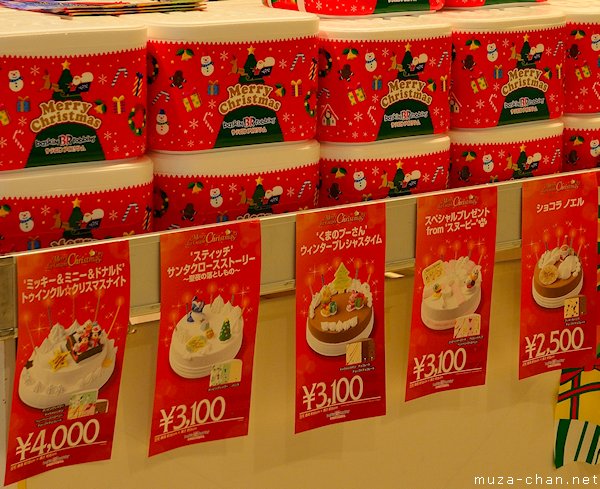
Japanese Christmas Cake
The Japanese Christmas cake is usually a sponge cake, ornamented with whipped cream, strawberries and a small Santa Claus figure. Of course, it wasn’t created especially for Christmas - this type of cake was sold until then as a cake for birthdays.
During the 1950s, when the refrigerators became widely spread throughout the country, the Christmas cake became a popular dessert served on Christmas Eve. Before this, there was even a joke saying “spoiled like a Christmas cake"… comparing the unrefrigerated Christmas cake after the date of 25th to an unmarried woman over the age of 25…
The second popular “Japanese Christmas food” appeared in 1974, when the KFC Colonel Sanders Santa appeared in Japan, part of a hugely successful marketing campaign. It is said that everything started when a foreign customer declared that he was eating chicken for Christmas because he was unable to find Christmas turkeys in Japan.
That created a new “tradition": eating fast food fried chicken on Christmas Eve - in 2005, a survey indicated that 1 of 3 Japanese adults were following this new tradition…
